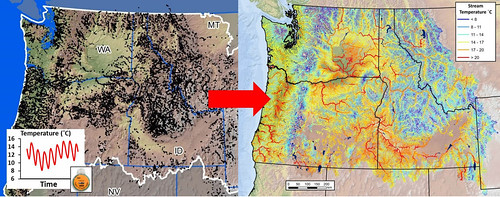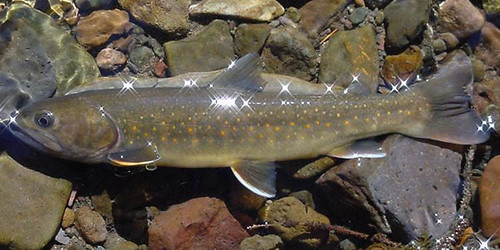
Climate change and species invasions raise fears that iconic cold-water species like trout, salmon, and char could be extirpated from most of their ranges this century.
A new study by researchers at the U.S. Forest Service Rocky Mountain Research Station published in Global Change Biology shows that high-resolution stream temperature scenarios can be used to forecast which streams will serve as climate refuges for native cutthroat and bull trout later this century and that many streams are forecast to be too cold to be invaded by non-native species.
Hence, the climate of the cold streams provides a “climate shield” that can be used to protect the two native trout species. The study encompassed all streams and more than 40 National Forests in the northwestern U.S. where significant concern exists about the future of cold-water species. Data for the study were crowd-sourced from hundreds of people working for dozens of resource agencies, with generous grants from the U.S. Fish and Wildlife Service Landscape Conservation Cooperatives that enabled the researchers to assemble the data into functional databases and develop accurate predictive models.
Two fisheries scientists, Dan Isaak and Mike Young, led the research. One finding brought good news—that some refuge streams with high probabilities of native trout population occupancy will exist for both species under both moderate and extreme climate change scenarios. A detailed analysis of the land administration associated with the refuges shows that 90 percent occur on public lands (70 percent on National Forests) but only about 15 percent are within watersheds formally protected as Wilderness Areas or National Parks.
By forecasting which streams are most likely to continue supporting the species, the research may enable key watersheds to be better protected, help rally support among multiple stakeholders, and provide a foundation for climate-smart planning of conservation networks that could sustain broader species distributions this century.
Getting to this stage with what Isaak and Young call the “Climate Shield” project has taken almost continuous effort over the past eight years to develop the necessary understanding, geospatial abilities, research teams, and big databases.
“It’s been a lot of fun to learn and work through the process, but it’s also humbling because so many people care so much about these species and they’ve been willing to share much of their hard-earned data with us,” said Isaak.
Hard earned, but by no means free, as the stream temperature data alone contributed to the project would cost $10 million to replicate. The big fish databases people shared would add millions more to that price-tag. But the researchers were able to pull it all together with a small database team and a few grants and now have the gratifying experience of serving “value added” information back to the people making on-the-ground decisions to protect these species.
Perhaps most exciting, the crowd-sourcing approach to doing science and climate vulnerability assessments has broad utility outside the region and the aquatics realm.
“Who doesn’t like high-quality information at low cost,” said Isaak. “It’s literally like being given free money, the political risks are greatly reduced for decision makers, and innumerable win-win situations and synergies are created.”
All the components required by this research—big databases, national geospatial map products, people who care—exist everywhere in the country, it’s just a matter of tapping into it. Because of the valuable information crowd-sourcing provides inexpensively, we’ll likely see more and more science done this way. As evidence of that, the researcher team is already getting requests from other parts of the country to expand Climate Shield.
Time will ultimately tell how far the crowdsourced Climate Shield data extends, but along the way social and collaborative networks are being strengthened, which is critical, because the people composing those networks are who must ultimately forge the strongest shield to protect and preserve many species through the 21st century.

